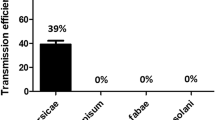Summary
The results of the first test indicate that the cauliflower mosaic virus belongs to the non-persistent viruses as defined byWatson enRoberts (1939).
The results of the second test, and the new definition of non-persistent viruses byWatson (1946) would, however, place cauliflower-mosaic in the persistent viruses.
WithMyzus persicae very short infection feeding times probably will result in a response to the period of preliminary fasting but withBrevicoryne brassicae this can not be expected. Therefore the definition ofWatson (1946) is in my opinion not an improvement of the definition ofWatson enRoberts (1939).
The response of the vectors to preliminary fasting time, with regard to the non-persistent viruses, is not constant and needs further research. From the results of the second test it is also evident that long infection feeding times do not always result in a deminishing of the efficiency of the vector; in certain cases they result in an increase in efficiency.
The results of the third trial make it evident that the virus protein is inactivated rapidly byMyzus persicae during a post infection fasting period. WithBrevicoryne brassicae this inactivation is very slow.
It may be that we have here a case of adaption of the cabbage aphid to the. cauliflower mosaic virus.
Similar content being viewed by others
Literatuur
Van Hoof, H. A. — 1954. Enkele gegevens over de melige koolluis (Brevicoryne brassicae L.) in het Geestmerambacht en zijn bestrijding. T.o.P. 60: 131–135.
Keuls, M. — 1952. The use of the „studentized range” in connection with an analysis of variance. Euphytica 1: 112–122.
Roberts, F. M. — 1940. Studies on the feeding methods and penetration rates of Myzus persicae (Sulz.), Myzus circumflexus (Buckt.) and Macrosiphum gei (Koch). Ann. appl. Biol. 27: 348–358.
Severin, H. H. P. &Tompkins, C. M. — 1948. Aphid transmission of cauliflower mosaic virus. Hilgardia 18: 389–404.
Watson, M. A. — 1946. The transmission of beet mosaic and beet yellows viruses by aphides; a comparative study of a non-persistent and a persistent virus having host plants and vectors in common. Proc. roy. Soc. B. 133: 200–219.
Watson, M. A. &Roberts, F. M. — 1939. A comparative study of the transmission of Hyocyamus virus 3, Potato virus Y and Cucumber virus 1 bij the vectors Myzus persicae (Sulz.), M. circumflexus (Buckton) and Macrosiphum gei (Koch). Proc. roy. Soc. B 127: 543–576.
Author information
Authors and Affiliations
Additional information
Voor de wiskundige verwerking van de gegevens zeg ikIr L. C. A. Corsten gaarne dank.
Rights and permissions
About this article
Cite this article
van Hoof, H.A. Verschilen in de overdracht van het bloemkoolmozaiekvirus bij Myzus persicae Sulzer en Brevicoryne brassicae L.. Tijdschrift Over Plantenziekten 60, 267–272 (1954). https://doi.org/10.1007/BF01980144
Received:
Issue Date:
DOI: https://doi.org/10.1007/BF01980144




